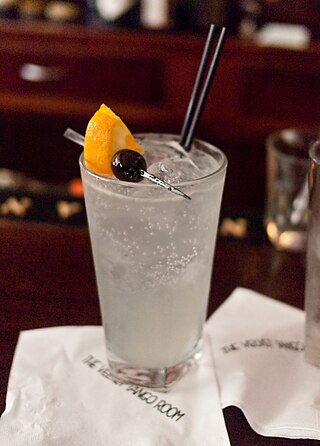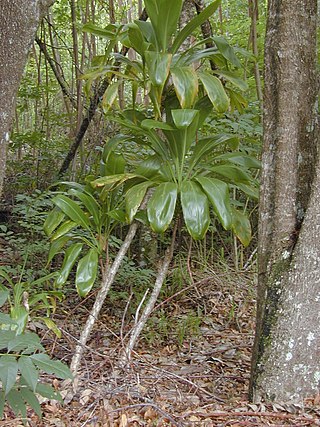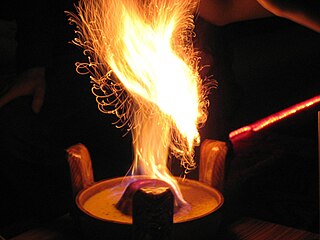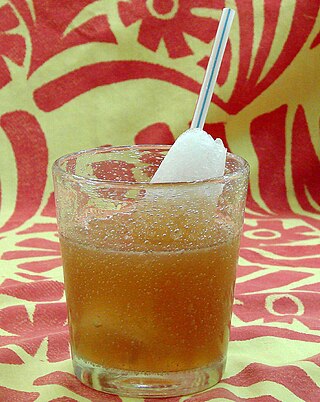Related Research Articles

The Tom Collins is a Collins cocktail made from gin, lemon juice, sugar, and carbonated water. First memorialized in writing in 1876 by Jerry Thomas, "the father of American mixology", this "gin and sparkling lemonade" drink is typically served in a Collins glass over ice with a cherry garnish. A non-alcoholic "Collins mix" mixer is produced, enjoyed by some as a soft drink.

The Mai Tai is a cocktail made of rum, Curaçao liqueur, orgeat syrup, and lime juice. It is one of the characteristic cocktails in Tiki culture.

The Zombie is a Tiki cocktail made of fruit juices, liqueurs, and various rums. It first appeared in late 1934, invented by Donn Beach at his Hollywood Don the Beachcomber restaurant. It was popularized on the East coast soon afterwards at the 1939 New York World's Fair.

Falernum is either an 11% ABV syrup liqueur or a nonalcoholic syrup from the Caribbean. It is best known for its use in tropical drinks. It contains flavors of ginger, lime, and almond, and frequently cloves or allspice. It may be thought of as a spicier version of orgeat syrup.
Fassionola is a typically red-colored fruit-flavored syrup that was frequently used in tropical drinks during the 1930s but is now a relatively unusual ingredient. It also comes in green and gold varieties that are sometimes made to taste differently. It is used as a fruit punch concentrate, and some claim that a red-colored fruit syrup called fassionola was an ingredient in the original Hurricane cocktail. Although a frequent attribution, solid evidence of fassionola's use in the Hurricane from before 1956 is lacking, and it is not known what the precise ingredients were in the earliest version of fassionola.

A sour is a traditional family of mixed drinks. Sours belong to one of the old families of original cocktails and are described by Jerry Thomas in his 1862 book How to Mix Drinks.

ʻŌkolehao is a Hawaiian alcoholic spirit whose main ingredient was the root of the ti plant. 'Ōkolehao's forerunner was a fermented ti root beverage or beer. When distillation techniques were introduced by English seamen in 1790, it was distilled into a highly alcoholic spirit.

A tiki mug is a large ceramic cocktail drinking vessel that originated in tiki bars and tropical-themed restaurants. The term "tiki mug" is a blanket term for the sculptural drinkware even though they vary in size and most do not contain handles. They typically depict Polynesian, mock-Polynesian, tropical, nautical, or retro themes, and as the term is used generically do not always emulate a tiki. When used to serve drinks they are frequently garnished with fruit or decorative drink umbrellas and swizzle sticks.

A tiki bar is a themed drinking establishment that serves elaborate cocktails, especially rum-based mixed drinks such as the Mai Tai and Zombie cocktails. Tiki bars are aesthetically defined by their tiki culture décor which is based upon a romanticized conception of tropical cultures, most commonly Polynesian. Some bars also incorporate general nautical themes or retro elements from the early atomic age.

Flaming volcano is a large tropical group cocktail typically made with rum, brandy, pineapple juice, orange juice, and orgeat syrup. Many variations exist, and the cocktail in the 21st century is more about the presentation than an adherence to a set list of ingredients. It is usually a multi-user drink, served to a group in a special vessel known as a volcano bowl, which is a decorative ceramic bowl designed with a rising central hub feature resembling a volcanic cone. The cone includes a "crater" reservoir which can be partially filled with rum or another flammable liquor. The crater liquor is carefully ignited when serving, creating a mild volcanic ambiance with its central blue flame.

The Navy Grog was a popular rum-based drink served for many years at the Polynesian-themed Don the Beachcomber restaurants; it is still served in many so-called tiki restaurants and bars. First created by Donn Beach, who almost single-handedly originated the tiki cultural fad of the 1940s and 1950s, it was one of dozens of rum concoctions that he, and later Trader Vic and numerous other imitators, sold in exotic tropical settings. Not quite as potent as the Beachcomber's more famous Zombie, it was, nevertheless, shown on the menu as being limited to two, or sometimes three, to a customer. Reportedly, Phil Spector consumed at least two Trader Vic’s Navy Grogs at the Beverly Hilton restaurant, without eating any food, the night he later killed actress Lana Clarkson.
Blow my skull is an alcoholic punch drink that originated in mid-19th century Australia. As listed in The English and Australian Cookery Book by Edward Abbott, it calls for two pints of boiling water, sugar loaf, lime or lemon juice, one pint of ale or porter, one pint rum, and a half a pint of brandy. It has been described as a "notoriously potent alcoholic concoction".

The doctor cocktail is a pre-prohibition era cocktail that traces in drink guides to as far back as 1917, when it appeared in Hugo R. Ensslin's Recipes for Mixed Drinks. As originally described the cocktail called simply for Swedish Punsch mixed with lime juice.

The suffering bastard is the name for two different mixed drinks, one being more of a standard cocktail associated with World War II and the other being more of an exotic drink associated with Tiki bars. As is the case with many cocktails, there are multiple recipe variations and historical origins have been argued and changed over time. Two of the earliest recipe versions have very different ingredients. One from bartender Joe Scialom (1942) calls for brandy and gin, while another from Tiki pioneer Victor J. Bergeron primarily uses rum along with "secret ingredients" and is known for being garnished with a cucumber.
The test pilot cocktail is a vintage tiki drink invented by Donn Beach. Beach was known for changing his recipes over time, and multiple versions of the test pilot attributed to both him and others make the cocktail one of his more frequently imitated and varied tiki drinks. Test pilot recipes call for multiple rums and typically include the use of falernum syrup and lime juice. The more popular also include Pernod (pastis/absinthe) and bitters.
Mr. Bali Hai is a tiki drink served in a special mug at the Bali Hai restaurant on Shelter Island in San Diego, California. The drink has had different recipes over the years, but a prominent version from the 1970s calls for 1 1/2 oz of dark Jamaican rum, 1 oz light Puerto Rican rum, 3/4 oz coffee flavored brandy, 1 1/2 oz unsweetened pineapple juice, 1 oz lemon juice, and 1/2 oz of sugar syrup. The mug has the same name as the drink, Mr. Bali Hai, and comes in the shape of a headhunter's head with a removable lid.
The Fog Cutter is a vintage tiki cocktail frequently attributed to being invented by Victor Bergeron that calls for a mixture of several liquors, the juice of lemon and oranges, orgeat syrup, and cream sherry. It is high in alcoholic content and has been called the "Long Island Iced Tea of exotic drinks." It has historically been served in special Fog Cutter ceramic mugs.
The PB2Y, or PB2Y Gremlin, is a tiki drink created by Victor Bergeron as part of a series of "gremlin" drinks for his Trader Vic's restaurants during World War II.
References
- ↑ "Scorpion Bowl". blog.distiller.com. Retrieved 16 February 2019.
- ↑ Riffs, Kitchen. "The Scorpion Cocktail" . Retrieved 2019-03-26.
- ↑ Vic, Trader (1972). Bartender's Guide, Revised (revised ed.). Garden City, NY: Doubleday. p. 179.
- ↑ Duggan McDonnell (2015). Drinking the Devil's Acre: A Love Letter from San Francisco and her Cocktails. Chronicle Books. pp. 94–97. ISBN 9781452140629 . Retrieved 11 December 2015.
- ↑ Berry, Jeff (2010). Beachbum Berry Remixed. San Jose: Club Tiki Press. p. 48.
- ↑ "Scorpion". blog.distiller.com. Retrieved 19 February 2019.
- ↑ "Tiki cocktail lost". punchdrink.com. 12 February 2019. Retrieved 19 February 2019.
- ↑ "Scorpion". gotrum.com. 13 June 2017. Retrieved 19 February 2019.
- ↑ Bergeron, Victor (1948). Bartender's Guide (Reprint ed.). Garden City Books.
- ↑ "Trader Vic's Menu". menus.nypl.org. Retrieved 16 February 2019.
- ↑ Carter, Duke (2003). Tiki Quest. Chicago: Pegboard Press. p. 80.
- ↑ Kirsten, Sven (2000). The Book of Tiki. Taschen. p. 146.
- ↑ Berry, Jeff (2010). Beachbum Berry Remixed. San Jose: Club Tiki Press.
- ↑ "From the Los Angeles Public Library Menu Collection: The Luau, a 1950s Tiki Bar in Beverly Hills". laweekly.com. 12 October 2012. Retrieved 17 February 2019.